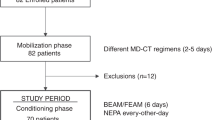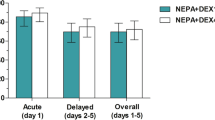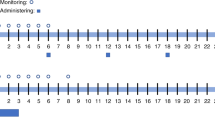Abstract
We investigated the pharmacokinetic profile and the efficacy of ondansetron (day 1) given as 16 mg suppository once a day, as compared with ondansetron 8 mg tablets twice daily, in patients receiving moderately emetogenic chemotherapy. The study was primarily aimed at investigating the pharmacokinetics and was part of a large multinational, randomised, double-blind, double-dummy efficacy trial. Pharmacokinetic data were obtained in a total of 20 patients, 11 of whom had received a suppository containing ondansetron, and nine patients had received the oral formulation. The median area under the plasma concentration curve (AUC) obtained with the oral formulation was 226 ng ml-1h-1 (range 91-750), and the median maximum plasma level (Cmax) was 50.5 ng ml-1 (range 24.7-199.6) after a dose of 8 mg. For the ondansetron suppository the median AUC was 140 ng ml-1h-1 range (77-405) and the median Cmax was 17.1 ng ml-1 (range 13-48.3) after a dose of 16 mg. The systemic exposure after correction for the dose difference after the suppository was on average 70% lower than after the tablet. The median time to reach the maximum level (Tmax) was 60 min (range 28-120) with the oral formulation and 209 min (range 90-420) with the suppository. For both the tablet and suppository, there was no apparent relationship between either Cmax or AUC, and efficacy. Although the patient numbers were too small for a formal exposure-response relationship to be derived, the slightly poorer pharmacokinetic performance of the suppository did not appear to be associated with a lessening of control of emesis following chemotherapy. The study demonstrates that the pharmacokinetic analysis of a once-daily 16 mg ondansetron suppository results in appropriate plasma concentrations and AUC, and that this rectal formulation is effective in the protection against nausea and vomiting associated with cyclophosphamide chemotherapy. This formulation will provide a useful alternative to the currently available oral formulation.
This is a preview of subscription content, access via your institution
Access options
Subscribe to this journal
Receive 24 print issues and online access
$259.00 per year
only $10.79 per issue
Buy this article
- Purchase on Springer Link
- Instant access to full article PDF
Prices may be subject to local taxes which are calculated during checkout
Similar content being viewed by others
Author information
Authors and Affiliations
Rights and permissions
About this article
Cite this article
de Wit, R., Beijnen, J., van Tellingen, O. et al. Pharmacokinetic profile and clinical efficacy of a once-daily ondansetron suppository in cyclophosphamide-induced emesis: a double blind comparative study with ondansetron tablets. Br J Cancer 74, 323–326 (1996). https://doi.org/10.1038/bjc.1996.361
Issue Date:
DOI: https://doi.org/10.1038/bjc.1996.361
This article is cited by
-
Design and evaluation of ondansetron liquid suppository for the treatment of emesis
Archives of Pharmacal Research (2013)
-
A pharmacokinetic interaction study of docetaxel and cisplatin plus or minus 5-fluorouracil in the treatment of patients with recurrent or metastatic solid tumors
Cancer Chemotherapy and Pharmacology (2006)
-
Management der Chemotherapie-induzierten Emesis: Was ist Standard nach 20 Jahren klinischer Forschung?
Medizinische Klinik (1998)



